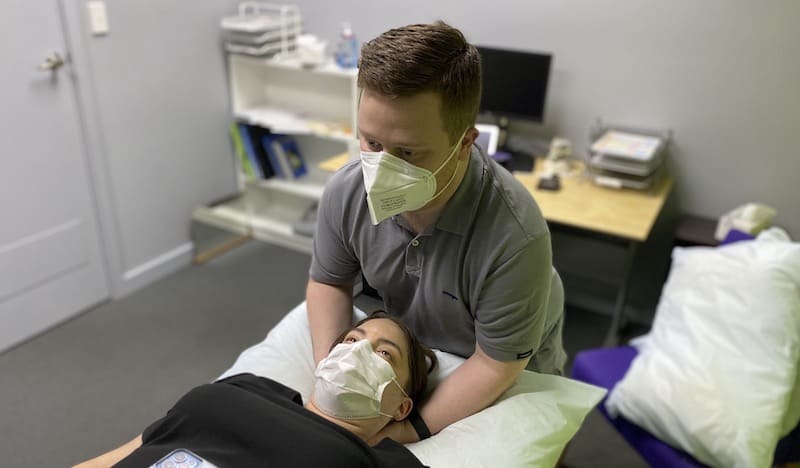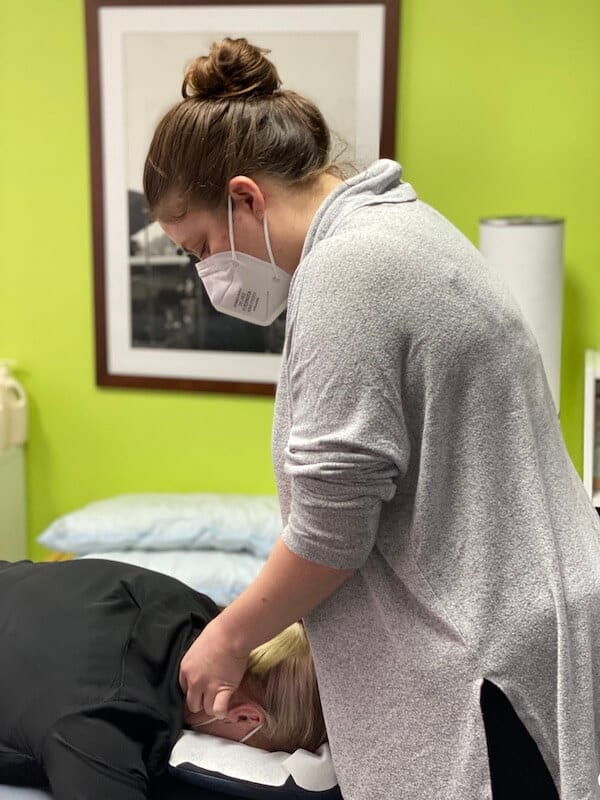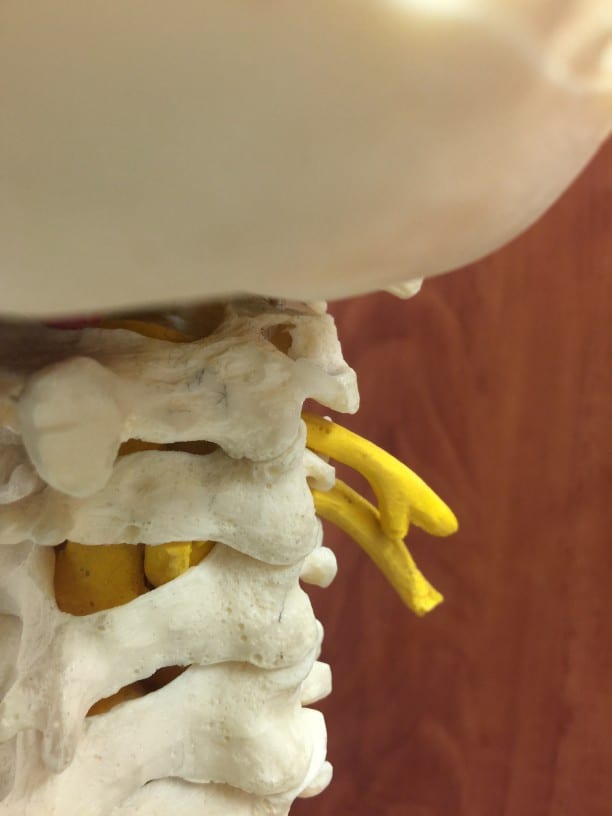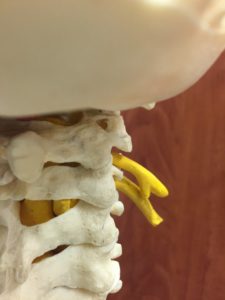We have continually attracted South Australia’s best physios, remedial massage therapists and support staff as a result of our culture and our values. And music. And fine coffee.
Neck Pain
Do you suffer from neck pain OR stiffness?
- Have you suddenly developed neck (cervical) pain?
- Have you had neck pain and stiffness for many years?
- Do you wake in the morning with neck stiffness that takes a hot shower to get going?
- Is it hard to turn your head far enough to check your blind spot?
- Do you have neck pain that radiates down to your shoulder, or even further down your arm?
- Do you have pins and needles or numbness in your arm or your hands?
- Do you have dizziness that is still unexplained?
Physiotherapy for neck pain is one of our core services along with headache and migraine treatment
If any of this is familiar, we would love to help you!
Are You Looking For Neck Pain Relief?
PLUS You'd like To:
- Keep control over your neck, upper back or arm pain?
- Get a clear treatment plan for the short term and the long term?
- Feel stronger, confident and more resilient with your neck?
- Get back to the things you love doing?
- Get a good night's sleep again?
- Get a quicker result from experienced physios?
- Dizziness problems that are related to the neck
Call us on (08) 7110 0848 or BOOK ONLINE
Let us help you get back to your best.
Are You Looking For Neck Pain Relief?
PLUS You'd like To:
- Keep control over your neck, upper back or arm pain?
- Get a clear treatment plan for the short term and the long term?
- Feel stronger, confident and more resilient with your neck?
- Get back to the things you love doing?
- Get a good night's sleep again?
- Get a quicker result from experienced physios?
- Find out if dizziness problems are related to your neck
Call us on (08) 7110 0848 or BOOK ONLINE
Let us help you get back to your best.
who do we help with NECK pain?

We assist people with:
- New episodes of neck pain including wry neck
- Headaches and migraine conditions off all descriptions
- Referred pain from the neck
- Longstanding, 'chronic' or persistent neck pain
- Injuries resulting from Motor Vehicle Accidents like whiplash and dizziness
- Workplace neck injuries
- Ergonomic assessment and advice
Many headache and migraine problems stem from problems in the upper cervical spine (the upper neck).
We have a dedicated Headache Clinic to help people suffering from these conditions.
We use the Watson Headache Approach to assess and treat headache and migraine conditions.
Click here to find about more about the Watson Headache Approach to answer all your questions
Whatever you are suffering from, we have seen it before!
What can you Expect from us?
- You can expect experienced physios with passion about helping people with acute and chronic neck pain
- You can expect a thorough assessment of your problem
- You can expect a clear plan of attack that allows you to understand your condition and make the fastest and most complete recovery
- You can expect up-to-date and research-based physiotherapy treatment
- You can expect excellent customer service and follow up even after you have finished treatment

How do we help people with NECK pain?
The first step is always a thorough examination.
Subjective examination: this is getting all the relevant information about your pain, how it behaves, what sets it off and what helps. There are lots of clues to help with diagnosis from this information.
It also means finding more about YOU ie what you do in your life, what kind of activities you normally do, and what you can’t do at the moment. This is the stuff you care about!
Red flags: these are indications of a problem that might be more serious and need further investigation by your doctor. While these conditions are relatively rare, they do happen. We have seen our fair share of ‘red flag’ conditions as first contact practitioners.
Objective examination: this is where we zero in on your restrictions to movement that your neck pain and neck muscles are creating.
We perform further examination with the cervical spine and upper back that gives us information beyond what a simple movement examination will provide.
Using the principles of the McKenzie Method, we look at how your pain or movement changes with repetition, which helps to build up a more comprehensive picture of the behaviour of the problem.
Neurological testing: if pain extends into either arm, we check your nerve function by testing strength, feeling and reflexes in the arm.
Naturally, you need to know what is wrong.
We aim to make it easy to understand the nature of the problem and why it hurts.
Pulling together all of the information from the assessment, we provide you with a provisional diagnosis for your problem on day one.
This is further refined over time as we see how you respond to treatment.
This step is really important: you need to go from assessment into treatment with a clear plan and an expected timeframe.
This management plan is developed together between you and the physio.
We make sure that it aligns with your needs and expectations.
With an acute neck pain problem, the initial goal will be helping reduce the acute pain and limitations.
This will be followed by helping the patient to stay painfree and moving freely, and then returning to activities, work or sports.
With a longstanding neck pain problem, the approach will be more nuanced depending on the presentation, but the aims will be the same.
As with all persistent pain problems, education is key with a longstanding neck pain problem.
We help the patient to have realistic beliefs about their problem and their pain .. and it usually involves increasing their expectations rather than limiting them!
Our physiotherapy treatment of neck pain is going to depend on the individual, but it might consist of:
- hands on treatment: manual therapy like joint mobilisation
- soft tissue massage and other techniques
- stretching
- education: about neck health, anatomy, pain, ergonomics and posture
- advice about the value of general exercise and how it can help with persistent pain problems
- specific exercises for the neck
We are all trained in the McKenzie Method for spinal problems (and upper and lower limb problems). This is a physiotherapy treatment approach which is a combination of pain-relieving exercise, education and hands-on treatment.
A full recovery involves not just becoming painfree, but also a return to activities that you have been prevented from doing, or you have been wary of doing.
We aim to introduce this step as early as possible whenever possible.
In fact, self management can often be introduced as early as the first consultation.
It can be any of the following: advice with ongoing self-treatment, exercise specific to the problem and more general exercise.
It often involves home exercise programs.
Maximising self-management is critical to reducing the need for ongoing treatment.
Our aim is not to create therapist-reliance, where you have to return for treatment indefinitely to ‘stay well’.
Instead, it is to help people to get to a stage where they can look after themselves and take control of their health
As with many pain problems, the rehabilitation isn’t over when the pain has settled.
The preventative steps will reduce the chances of being in the same situation again.
We advise on the best ways to avoid recurrent neck pain through exercise, posture, movement and education.
Whether you have been looking for help with your neck for many years, or the pain has just appeared this morning …
Get a FREE PHYSIO PHONE CONSULT to find out how we can help!
Call us on 8356 1000 or BOOK ONLINE
Our NECK pain approach - how we are different
- We use the McKenzie method and the Watson Headache Approach as the basis for our treatment.
This means a logical testing approach looking at the response to different movements to find a ‘directional preference’.
The results tell us about the type of neck pain problem, how quickly it will likely improve, and what the correct approach should be.
Alternatively, it quickly tells us if physical treatment isn’t appropriate for the problem.
We don’t use electrotherapy.
There is no evidence to suggest that it has a place in treatment of neck pain problems.We have skills in treatment of ongoing neck pain.
Our approach combines manual therapy, exercise, and critically, helping the patient understand what is behind their pain.
We are constantly exploring new ideas.
We stay up-to-date with current knowledge through our twice weekly professional development sessions.We will make sure you are heard.
We understand that not being heard can be one of the most frustrating things that a patient can experience.
- We use the McKenzie method and the Watson Headache Approach as the basis for our treatment.

Our NECK pain approach - how we are different
- We use the McKenzie method as the basis for our treatment.
This means a structured testing to see the response to different movements to find a ‘directional preference’.
The results tell us about the type of neck pain problem, how quickly it will likely improve, and what the correct approach should be.
Alternatively, it quickly tells us if physical treatment isn’t appropriate for the problem. - We don’t use electrotherapy: there is no evidence to suggest that it has a place in treatment of neck pain problems.
- We have skills in treatment of ongoing neck pain: an approach that combines manual therapy, exercise, and critically, helping the patient understand what is behind their pain.
- We are constantly exploring new ideas and staying up-to-date with current knowledge through our twice weekly professional development sessions.
- We will make sure you are heard. We understand that not being heard can be one of the most frustrating things that a patient can experience.

Does this sound like you?
If you are anything like the thousands of people we have helped with physiotherapy treatment over the last decade, you might have already done the rounds.
And despite all this, you might not really know why it is hurting.
- You might have seen your GP (or you aren't sure if you should).
- You could have already had prolonged periods of chiropractor, physio, osteopath or another therapy.
- Maybe you have had XRays or an MRI scan or other imaging. Maybe there is a report that sounds impressive but scary.
- You might have even been told that you need injections or surgery.
- And you might be asking yourself 'is my neck always going to be like this?'
We understand.
Call us on 8356 1000 or BOOK ONLINE
and find out how we can help you take the first steps for getting back to your best!
CERVICAL problems we treat
You can hear many different structures and different terms as the cause for your neck pain:
• the intervertebral disc: disc problems can be described as disc strain, pain from bulging disc, pain from herniated disc, disc extrusion or even disc sequestration
• the facet joint (also known as zygapophyseal joint): you might hear of facet joint pain, facet joint dysfunction, so-called degenerative changes of the facet joints
• nerve tissue: terms that are often used are nerve root compression, nerve pain, nerve root pain and nerve root irritation
• neck muscles: these get a lot of blame with names like myofascial pain, muscle pain, muscle strains, upper trapezius overactivity, scapular muscle dysfunction and trigger points
• muscles have often been blamed as the cause of neck pain: weak deep neck flexors or overactive scalenes, upper trapezius and levator scapulae muscles
• reasons related to cervical vertebra bone: these include things like exit foraminal stenosis, central canal stenosis
Sometimes it’s just given the horrible and scary diagnosis ‘osteoarthritis of the cervical spine’ or ‘cervical spondylosis.
We treat all of these conditions.

CERVICAL problems we treat
You will hear your neck pain blamed on many different structures and using many different terms:
• the intervertebral disc: disc problems can be described as disc strain, pain from bulging disc, pain from herniated disc, disc extrusion or even disc sequestration
• the facet joint (also known as zygapophyseal joint): you might hear of facet joint pain, facet joint dysfunction, so-called degenerative changes of the facet joints
• nerve tissue: terms that are often used are nerve root compression, nerve pain, nerve root pain and nerve root irritation
• neck muscles: lots of blame is put on the neck muscles with names like myofascial pain, muscle pain, muscle strains, upper trapezius overactivity, scapular muscle dysfunction, trigger points
• muscles have often been blamed as the cause of neck pain: weak deep neck flexors or overactive scalenes, upper trapezius and levator scapulae muscles
• reasons related to cervical vertebra bone: these include things like exit foraminal stenosis, central canal stenosis
Sometimes it’s just given the horrible and scary diagnosis ‘osteoarthritis of the cervical spine’ or ‘cervical spondylosis.
We treat all of these conditions.

Further neck pain resources
Headache Clinic – Our headache and migraine service to help sufferers of a wide variety of these conditions.
Headache and Migraine – How To Spot If Your Neck Is A Culprit – The neck is a really common contributor or cause of headache and migraine. This article will give you some ideas to help you know if you aren’t sure.
Neck injury – Do You Know What To Do? Would you know what to do if someone suffered a neck injury in your presence?
Trigeminocervical Nucleus – The key to headaches and migraines has the word ‘cervical’ in it, and it isn’t a coincidence! The trigeminocervical nucleus is involved in all head pain, headache pain and migraine.
Physio Pillow and Sleeping Position Recommendations<-The best advice you can find on the internet about pillows and sleeping positions
Pain Science Nuggets – a collection of short chunks of information to help you understand how pain actually works. We know that understanding pain better has a direct effect on all pain.
5 Simple Exercises For Headache Relief – Need some simple neck exercises to help with headaches? This article presents our top 5 exercises plus one stretch that everyone gets shown (but we NEVER use).
Frequently-asked questions
Here are the most frequently-asked questions, but there are hundreds more. If you have a specific question, ring us on 8356 1000 and organise a time to have a chat with a physio.
Let us help you get the correct information for YOU.
Yes, we do dry needling if it is clinically indicated. Mention that it is something that interests you when you book in.
You certainly will!
No you don’t.
Physios are first contact practitioners which means they are able to screen for any serious conditions that might require further investigations.
If we feel that seeing your GP for medication or imaging is required, we will suggest it to you and refer you to your GP.
No.
Diagnosis is able to be made based on history and examination.
There are situations where imaging might be worthwhile, mainly to rule out any serious conditions. If required, we will let you know and refer back to your GP.
XRays and scans are not recommended under medical guidelines unless there is suspicion of a ‘red flag’ condition.
We certainly do, but that will never make up the entirety of the treatment.
We will use hands-on treatment while it is effective, and it can be particularly useful in the initial stages of settling acute pain.
However as soon as practical, we will look to strategies that don’t require hands-on treatment to allow you to be independent and less reliant on a health care practitioner.
No, as there is no evidence to support its use.
This rationale is discussed in detail in an article called ‘How The Best Adelaide Physios Solve Back Pain in 2022’
Get Started Today On Your Path To
LESS PAIN +
LESS MEDICATION
Book online 24/7, call us or chat on Facebook Messenger to get more details
Subscribe to our newsletter
We have continually attracted South Australia’s best physios, remedial massage therapists and support staff as a result of our culture and our values. And music. And fine coffee.
Site Map
- 8356 1000
- 8356 1200
- admin@adelaidewestphysio.com.au
- Facebook Messenger
- 506 Henley Beach Road FULHAM South Australia 5024
©2022 - Adelaide West Physio + Pilates | Headache Clinic. All rights reserved
©2022 - Adelaide West Physio + Pilates | Headache Clinic – All rights reserved
©2024 - Adelaide West Physio + Pilates | Headache Clinic – All rights reserved